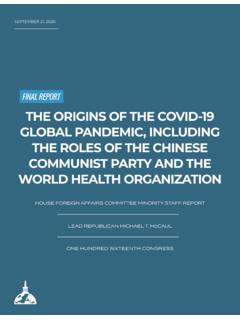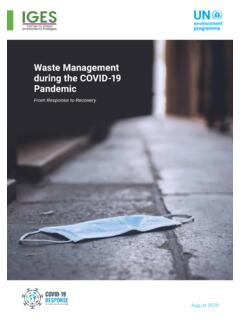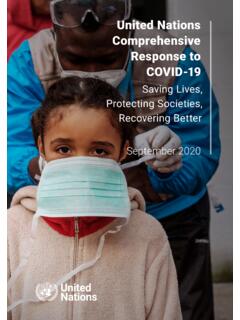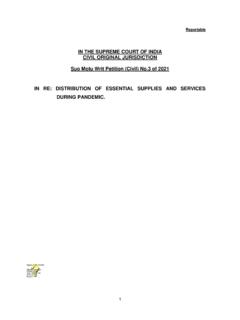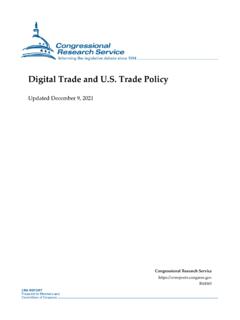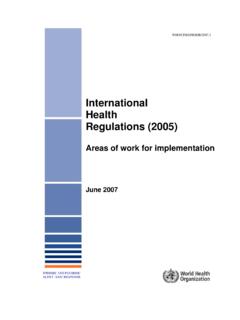Transcription of THE NATIONAL STRATEGY FOR PANDEMIC INFLUENZA
1 NATIONAL STRATEGY for PANDEMIC INFLUENZA homeland security council november 2005 NATIONAL STRATEGY for PANDEMIC INFLUENZA h omeland security COUNCIL november 2005 My fellow Americans, Once again, nature has presented us with a daunting challenge: the possibility of an INFLUENZA PANDEMIC . Most of us are accustomed to seasonal INFLUENZA , or the flu, a viral infection that continues to be a significant public health challenge. From time to time, changes in the INFLUENZA virus result in a new strain to which people have never been exposed. These new strains have the potential to sweep the globe, causing millions of illnesses, in what is called a PANDEMIC . A new strain of INFLUENZA virus has been found in birds in Asia, and has shown that it can infect humans. If this virus undergoes further change, it could very well result in the next human PANDEMIC . We have an opportunity to prepare ourselves, our Nation, and our world to fight this potentially devastating outbreak of infectious disease.
2 The NATIONAL STRATEGY for PANDEMIC INFLUENZA presents our approach to address the threat of PANDEMIC INFLUENZA , whether it results from the strain currently in birds in Asia or another INFLUENZA virus. It outlines how we intend to prepare, detect, and respond to a PANDEMIC . It also outlines the important roles to be played not only by the Federal government, but also by State and local governments, private industry, our international partners, and most importantly individual citizens, including you and your families. While your government will do much to prepare for a PANDEMIC , individual action and individual responsibility are necessary for the success of any measures. Not only should you take action to protect yourself and your families, you should also take action to prevent the spread of INFLUENZA if you or anyone in your family becomes ill. Together we will confront this emerging threat and together, as Americans, we will be prepared to protect our families, our communities, this great Nation, and our world.
3 GEORGE W. BUSH THE WHITE HOUSE November 1, 2005 NATIONAL STRATEGY FOR PANDEMIC INFLUENZA NATIONAL STRATEGY FOR PANDEMIC INFLUENZA TABLE OF CONTENTS INTRODUCTION .. 1 THE PANDEMIC THREAT .. 1 THE NATIONAL STRATEGY FOR PANDEMIC INFLUENZA .. 2 PILLARS OF THE NATIONAL STRATEGY .. 3 IMPLEMENTATION OF THE NATIONAL STRATEGY .. 3 PILLAR ONE: PREPAREDNESS AND 4 PILLAR TWO: SURVEILLANCE AND DETECTION .. 7 PILLAR THREE: RESPONSE AND 8 ROLES AND RESPONSIBILITIES .. 10 NATIONAL STRATEGY FOR PANDEMIC INFLUENZA - 1 - NATIONAL STRATEGY FOR PANDEMIC INFLUENZA INTRODUCTION Although remarkable advances have been made in science and medicine during the past century, we are constantly reminded that we live in a universe of microbes - viruses, bacteria, protozoa and fungi that are forever changing and adapting themselves to the human host and the defenses that humans create. INFLUENZA viruses are notable for their resilience and adaptability.
4 While science has been able to develop highly effective vaccines and treatments for many infectious diseases that threaten public health, acquiring these tools is an ongoing challenge with the INFLUENZA virus. Changes in the genetic makeup of the virus require us to develop new vaccines on an annual basis and forecast which strains are likely to predominate. As a result, and despite annual vaccinations, the faces a burden of INFLUENZA that results in approximately 36,000 deaths and more than 200,000 hospitalizations each year. In addition to this human toll, INFLUENZA is annually responsible for a total cost of over $10 billion in the A PANDEMIC , or worldwide outbreak of a new INFLUENZA virus, could dwarf this impact by overwhelming our health and medical capabilities, potentially resulting in hundreds of thousands of deaths, millions of hospitalizations, and hundreds of billions of dollars in direct and indirect costs.
5 This STRATEGY will guide our preparedness and response activities to mitigate that impact. THE PANDEMIC THREAT Pandemics happen when a novel INFLUENZA virus emerges that infects and can be efficiently transmitted between humans. Animals are the most likely reservoir for these emerging viruses; avian viruses played a role in the last three INFLUENZA pandemics. Two of these PANDEMIC -causing viruses remain in circulation and are responsible for the majority of INFLUENZA cases each year. Pandemics have occurred intermittently over centuries. The last three pandemics, in 1918, 1957 and 1968, killed approximately 40 million, 2 million and 1 million people worldwide, respectively. Although the timing cannot be predicted, history and science suggest that we will face one or more pandemics in this century. The current PANDEMIC threat stems from an unprecedented outbreak of avian INFLUENZA in Asia and Europe, caused by the H5N1 strain of the INFLUENZA A virus.
6 To date, the virus has infected birds in 16 countries and has resulted in the deaths, through illness and culling, of approximately 200 million birds across Asia. While traditional control measures have been attempted, the virus is now endemic in Southeast Asia, present in long-range migratory birds, and unlikely to be eradicated soon. A notable and worrisome feature of the H5N1 virus is its ability to infect a wide range of hosts, including birds and humans. As of the date of this document, the virus is known to have infected 121 people in four countries, resulting in 62 deaths over the past two years. Although the virus has not yet shown an ability to transmit efficiently between humans, as is seen with the annual INFLUENZA virus, there is concern that it will acquire this capability through genetic mutation or exchange of genetic material with a human INFLUENZA virus. It is impossible to know whether the currently circulating H5N1 virus will cause a human PANDEMIC .
7 The widespread nature of H5N1 in birds and the likelihood of mutations over time raise our concerns that the virus will become transmissible between humans, with potentially catastrophic consequences. If this does not happen with the current H5N1 strain, history suggests that a different INFLUENZA virus will emerge and result in the next PANDEMIC . THE NATIONAL STRATEGY FOR PANDEMIC INFLUENZA Preparing for a PANDEMIC requires the leveraging of all instruments of NATIONAL power, and coordinated action by all segments of government and society. INFLUENZA viruses do not respect the distinctions of race, sex, age, profession or nationality, and are not constrained by geographic boundaries. The next PANDEMIC is likely to come in waves, each lasting months, and pass through communities of all size across the nation and world. While a PANDEMIC will not damage power lines, banks or computer networks, it will ultimately threaten all critical infrastructure by removing essential personnel from the workplace for weeks or months.
8 This makes a PANDEMIC a unique circumstance necessitating a STRATEGY that extends well beyond health and medical boundaries, to include the sustainment of critical infrastructure, private-sector activities, the movement of goods and services across the nation and the globe, and economic and security considerations. The uncertainties associated with INFLUENZA viruses require that our STRATEGY be versatile, to ensure that we are prepared for any virus with PANDEMIC potential, as well as the annual burden of INFLUENZA that we know we will face. The NATIONAL STRATEGY for PANDEMIC INFLUENZA guides our preparedness and response to an INFLUENZA PANDEMIC , with the intent of (1) stopping, slowing or otherwise limiting the spread of a PANDEMIC to the United States; (2) limiting the domestic spread of a PANDEMIC , and mitigating disease, suffering and death; and (3) sustaining infrastructure and mitigating impact to the economy and the functioning of society.
9 The STRATEGY will provide a framework for future Government planning efforts that is consistent with The NATIONAL Security STRATEGY and the NATIONAL STRATEGY for Homeland Security. It recognizes that preparing for and responding to a PANDEMIC cannot be viewed as a purely federal responsibility, and that the nation must have a system of plans at all levels of government and in all sectors outside of government that can be integrated to address the PANDEMIC threat. It is guided by the following principles: The federal government will use all instruments of NATIONAL power to address the PANDEMIC threat. States and communities should have credible PANDEMIC preparedness plans to respond to an outbreak within their jurisdictions. The private sector should play an integral role in preparedness before a PANDEMIC begins, and should be part of the NATIONAL response. Individual citizens should be prepared for an INFLUENZA PANDEMIC , and be educated about individual responsibility to limit the spread of infection if they or their family members become ill.
10 Global partnerships will be leveraged to address the PANDEMIC threat. NATIONAL STRATEGY FOR PANDEMIC INFLUENZA - 2 - PILLARS OF THE NATIONAL STRATEGY Our STRATEGY addresses the full spectrum of events that link a farmyard overseas to a living room in America. While the circumstances that connect these environments are very different, our strategic principles remain relevant. The pillars of our STRATEGY are: Preparedness and Communication: Activities that should be undertaken before a PANDEMIC to ensure preparedness, and the communication of roles and responsibilities to all levels of government, segments of society and individuals. Surveillance and Detection: Domestic and international systems that provide continuous situational awareness, to ensure the earliest warning possible to protect the population. Response and Containment: Actions to limit the spread of the outbreak and to mitigate the health, social and economic impacts of a PANDEMIC .










